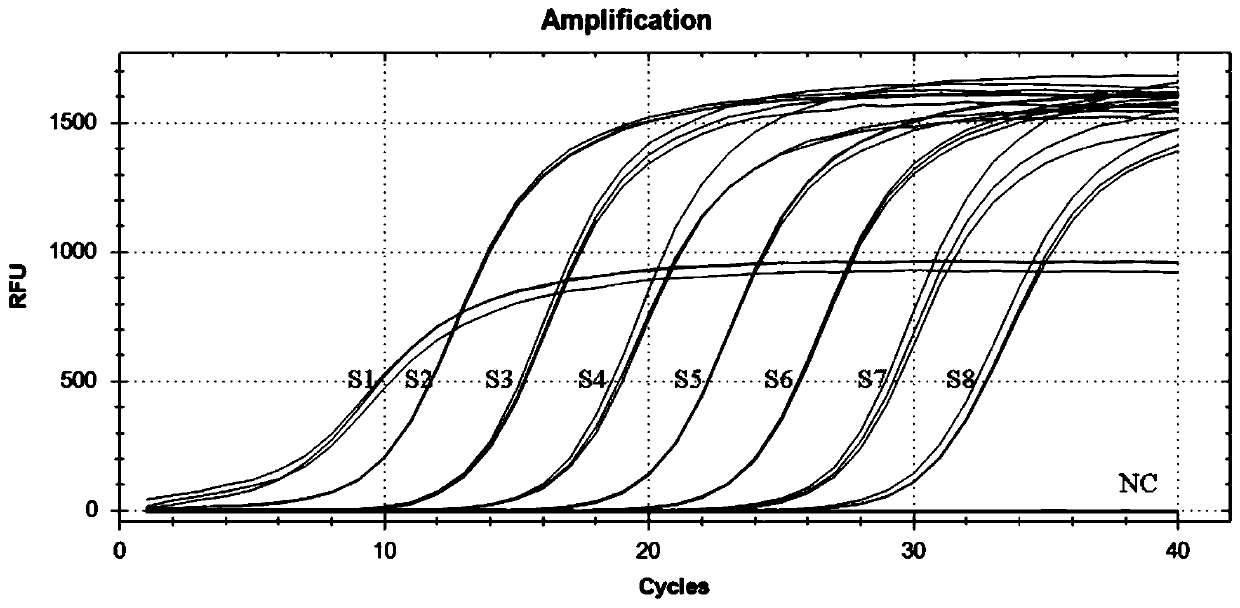Porcine reproductive and respiratory syndrome virus real-time fluorescent quantitation PCR detection kit and primer
A porcine PRRS virus, real-time fluorescence quantitative technology, applied in the determination/inspection of microorganisms, microorganisms, microorganism-based methods, etc. The detection of highly pathogenic porcine PRRS virus and porcine PRRS virus takes a long time, specificity, and sensitivity, etc., to achieve the effect of high sensitivity, short time and strong specificity
- Summary
- Abstract
- Description
- Claims
- Application Information
AI Technical Summary
Problems solved by technology
Method used
Image
Examples
Embodiment 1
[0020] Example 1: Real-time PCR kit for detecting porcine PRRS virus
[0021] The present invention provides a kit for detecting porcine PRRS virus by real-time fluorescence quantitative PCR using SYBR Green dye method, which comprises reagents including SYBR Premix EX Taq (purchased from Bao Bioengineering (Dalian)), primers, ROX, Rnase-FreeddH 2 O. Positive reference. The following examples are all tested with CFX96 instrument without special instructions.
[0022] The primers are a pair, which are specific forward and reverse primers designed for the highly conserved region of porcine PRRS virus (including classic porcine PRRS virus, highly pathogenic porcine PRRS virus and the newly mutated strain-NADC30). Its sequences are shown in SEQ ID NO:1 and SEQ ID NO:2.
[0023] The forward primer sequence represented by SEQ ID NO: 1 is as follows:
[0024] 5’-GCCGKTTGTGCTTGCT-3’
[0025] The reverse primer sequence represented by SEQ ID NO:2 is as follows:
[0026] 5’-TGCGTGG...
Embodiment 2
[0043] Example 2: Preparation of positive standard standard curve
[0044]The positive standard of this kit is composed of plasmids containing the target fragment. The positive standard is diluted 10-fold with TE buffer. The dilution gradient is as follows: the concentrations of S1 to S10 are 1.0×10 9 copies / μL, 1.0×10 8 copies / μL, 1.0×10 7 copies / μL, 1.0×10 6 copies / μL, 1.0×10 5 copies / μL, 1.0×10 4 copies / μL, 1.0×10 3 copies / μL, 1.0×10 2 copies / μL, 1.0×10 1 copies / μL, 1.0 copies / μL. Quantitative PCR detection was carried out with the kit and method described in Example 1 using the above-mentioned fold-diluted standard as a template.
[0045] ginseng figure 1 and figure 2 , the results show that the standard concentration is between S1~S8 (1.0×10 9 copies / μL~1.0×10 2 It has a good linear relationship in the range of copies / μL), S9~S10 (1.0×10 1 copies / μL~1.0copies / μL) detected no linear relationship, and only one well of S9 showed positive amplification. in, f...
Embodiment 3
[0046] Example 3: Sensitivity and Repeatability
[0047] In order to verify the minimum detection limit and reproducibility of the detection kit, the sensitivity of porcine PRRS was tested with positive standard S4-S10 as reference and repeated three times.
[0048] ginseng image 3 , the results show that the positive standards S4~S8 are all amplified, the Ct value is ≤32, the Tm value is 86.0, and only one well of S9 has positive amplification, which does not meet the requirements, so the detection limit of this kit is 1.0 × 10 2 copies / μL.
PUM
 Login to View More
Login to View More Abstract
Description
Claims
Application Information
 Login to View More
Login to View More - R&D
- Intellectual Property
- Life Sciences
- Materials
- Tech Scout
- Unparalleled Data Quality
- Higher Quality Content
- 60% Fewer Hallucinations
Browse by: Latest US Patents, China's latest patents, Technical Efficacy Thesaurus, Application Domain, Technology Topic, Popular Technical Reports.
© 2025 PatSnap. All rights reserved.Legal|Privacy policy|Modern Slavery Act Transparency Statement|Sitemap|About US| Contact US: help@patsnap.com



